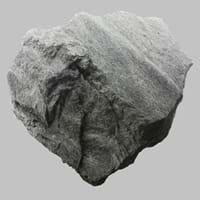Definition
Breccia is a rock consisting of angular fragments of stones which are cemented by finer calcareous material
Phyllite is a fine-grained metamorphic rock with a well-developed laminar structure, and is intermediate between slate and schist rocks
Discoverer
Unknown
Unknown
Etymology
From Italian, literally gravel, Germanic origin and related to break
From Greek phullon leaf + -ite1
Class
Sedimentary Rocks
Metamorphic Rocks
Sub-Class
Durable Rock, Hard Rock
Durable Rock, Soft Rock
Group
Not Applicable
Not Applicable
Other Categories
Coarse Grained Rock, Medium Grained Rock, Opaque Rock
Coarse Grained Rock, Fine Grained Rock, Medium Grained Rock, Opaque Rock
Texture
Brecciated, Clastic
Phyllitic Sheen, Slaty
Color
Beige, Black, Blue, Brown, Buff, Green, Grey, Orange, Pink, Purple, Red, Rust, White, Yellow
Black to Grey, Light Greenish Grey
Durability
Durable
Durable
Appearance
Layered, Banded, Veined and Shiny
Crinkled or Wavy
Interior Uses
Countertops, Decorative Aggregates, Entryways, Floor Tiles, Flooring, Homes, Hotels, Interior Decoration
Decorative Aggregates, Floor Tiles, Homes, Interior Decoration
Exterior Uses
As Building Stone, As Facing Stone, Paving Stone, Garden Decoration, Office Buildings
As Building Stone, As Facing Stone, Garden Decoration
Other Architectural Uses
Curbing
Curbing
Construction Industry
As Dimension Stone, Construction Aggregate, Landscaping, Roadstone
As Dimension Stone, Building houses or walls, Cement Manufacture, Construction Aggregate, for Road Aggregate, Raw material for the manufacture of mortar, Roadstone
Medical Industry
Not Yet Used
Not Yet Used
Antiquity Uses
Artifacts, Sculpture
Artifacts, Sculpture
Commercial Uses
Creating Artwork, Gemstone, Jewelry
Cemetery Markers, Commemorative Tablets, Creating Artwork, Writing Slates
Types
Collapse Breccia, Fault Breccia, Flow Breccia, Pyroclastic Breccia, Igneous Breccia and Impact Breccia
Not Available
Features
Available in Lots of Colors and Patterns, Clasts are smooth to touch
Easily splits into thin plates, Is one of the oldest rock, Surfaces are often shiny
Archaeological Significance
Monuments
Not Yet Used
Not Yet Used
Famous Monuments
Not Applicable
Not Applicable
Famous Sculptures
Data Not Available
Data Not Available
Pictographs
Not Used
Used
Petroglyphs
Not Used
Used
Formation
Breccia is a clastic sedimentary rock which is composed of broken fragments of minerals or rock which are cemented together by a fine-grained matrix and it forms where broken, angular fragments of rock or mineral debris accumulate.
Phyllite is a metamorphic rock which is formed by regional metamorphism of argillaceous sediments since their cleavage arose due to deviatoric stress.
Mineral Content
Calcite, Clay, Feldspar, Phosphates, Quartz, Silica
Albite, Alusite, Amphibole, Apatite, Biotite, Chlorite, Epidote, Feldspar, Garnet, Graphite, Hornblade, Kyanite, Micas, Muscovite or Illite, Porphyroblasts, Quartz, Sillimanite, Staurolite, Talc, Zircon
Compound Content
Aluminium Oxide, Ca, NaCl, CaO, Iron(III) Oxide, Potassium Oxide, Sodium Oxide, Silicon Dioxide, Titanium Dioxide
CaO, Carbon Dioxide, MgO
Types of Metamorphism
Burial Metamorphism, Cataclastic Metamorphism
Not Applicable
Types of Weathering
Biological Weathering, Chemical Weathering, Mechanical Weathering
Biological Weathering, Chemical Weathering, Mechanical Weathering
Types of Erosion
Chemical Erosion
Chemical Erosion, Coastal Erosion, Glacier Erosion, Water Erosion, Wind Erosion
Grain Size
Medium to Coarse Grained
Medium to Fine Coarse Grained
Fracture
Uneven
Conchoidal
Porosity
Less Porous
Highly Porous
Luster
Dull to Pearly
Phyllitic
Cleavage
Non-Existent
Crenulation and Pervasive
Toughness
Not Available
1.2
Specific Gravity
2.86-2.87
2.72-2.73
Transparency
Opaque
Opaque
Density
0 g/cm3
2.18-3.3 g/cm3
Resistance
Heat Resistant, Impact Resistant, Pressure Resistant, Wear Resistant
Heat Resistant, Pressure Resistant, Water Resistant
Deposits in Eastern Continents
Asia
China, India, Kazakhstan, Mongolia, Russia, South Korea, Uzbekistan
Afghanistan, Bangladesh, Bhutan, China, India, Japan, Kazakhstan, Malaysia, Pakistan, Russia, Thailand, Turkey, Vietnam
Africa
Namibia, Nigeria, South Africa
Egypt, Ethiopia, Morocco, Nigeria, South Africa
Europe
Austria, Denmark, Germany, Great Britain, Netherlands, Norway, Poland, Sweden, Switzerland, United Kingdom
Austria, England, France, Georgia, Germany, Italy, Liechtenstein, Monaco, Norway, Slovenia, Spain, Sweden, Switzerland
Others
Greenland
Not Yet Found
Deposits in Western Continents
North America
Barbados, Canada, Mexico, Panama, USA
Canada, Costa Rica, Cuba, Mexico, Panama, USA
South America
Brazil
Brazil, Colombia, Guyana
Deposits in Oceania Continent
Australia
New South Wales, New Zealand
New South Wales, New Zealand, Queensland
All about Breccia and Phyllite Properties
Know all about Breccia and Phyllite properties here. All properties of rocks are important as they define the type of rock and its application. Breccia belongs to Sedimentary Rocks while Phyllite belongs to Metamorphic Rocks.Texture of Breccia is Brecciated, Clastic whereas that of Phyllite is Phyllitic Sheen, Slaty. Breccia appears Layered, Banded, Veined and Shiny and Phyllite appears Crinkled or Wavy. The luster of Breccia is dull to pearly while that of Phyllite is phyllitic. Breccia is available in beige, black, blue, brown, buff, green, grey, orange, pink, purple, red, rust, white, yellow colors whereas Phyllite is available in black to grey, light greenish grey colors. The commercial uses of Breccia are creating artwork, gemstone, jewelry and that of Phyllite are cemetery markers, commemorative tablets, creating artwork, writing slates.










